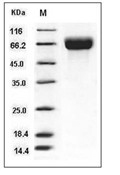Shopping Cart
- Remove All
 Your shopping cart is currently empty
Your shopping cart is currently empty

CD98 Protein, Human, Recombinant (His) is expressed in HEK293 mammalian cells with His tag. The predicted molecular weight is 49.2 kDa and the accession number is P08195-1.

| Pack Size | Price | Availability | Quantity |
|---|---|---|---|
| 100 μg | 1.330 € | In Stock | |
| 200 μg | 1.995 € | 7-10 days | |
| 500 μg | 3.391 € | 7-10 days |
| Biological Activity | Activity testing is in progress. It is theoretically active, but we cannot guarantee it. If you require protein activity, we recommend choosing the eukaryotic expression version first. |
| Description | CD98 Protein, Human, Recombinant (His) is expressed in HEK293 mammalian cells with His tag. The predicted molecular weight is 49.2 kDa and the accession number is P08195-1. |
| Species | Human |
| Expression System | HEK293 Cells |
| Tag | N-His |
| Accession Number | P08195-1 |
| Synonyms | solute carrier family 3 (amino acid transporter heavy chain), member 2,NACAE,MDU1,CD98HC,CD98,4T2HC,4F2HC,4F2 |
| Construction | A DNA sequence encoding the human SLC3A2 isoform 1 (P08195-1) (Arg 206-Ala 630) was expressed, with a polyhistidine tag at the N-terminus. Predicted N terminal: His |
| Protein Purity | > 97 % as determined by SDS-PAGE  |
| Molecular Weight | 49.2 kDa (predicted); 65-75 kDa (reducing condition, due to glycosylation) |
| Endotoxin | < 1.0 EU/μg of the protein as determined by the LAL method. |
| Formulation | Lyophilized from a solution filtered through a 0.22 μm filter, containing PBS, pH 7.4. Typically, a mixture containing 5% to 8% trehalose, mannitol, and 0.01% Tween 80 is incorporated as a protective agent before lyophilization. |
| Reconstitution | A Certificate of Analysis (CoA) containing reconstitution instructions is included with the products. Please refer to the CoA for detailed information. |
| Stability & Storage | It is recommended to store recombinant proteins at -20°C to -80°C for future use. Lyophilized powders can be stably stored for over 12 months, while liquid products can be stored for 6-12 months at -80°C. For reconstituted protein solutions, the solution can be stored at -20°C to -80°C for at least 3 months. Please avoid multiple freeze-thaw cycles and store products in aliquots. |
| Shipping | In general, Lyophilized powders are shipping with blue ice. |
| Research Background | 4F2 cell-surface antigen heavy chain, also known as 4F2 heavy chain antigen, Lymphocyte activation antigen 4F2 large subunit, CD98, SLC3A2 and MDU1, is a single-pass type I I membrane protein that belongs to the SLC3A transporter family. SLC3A2 / MDU1 is expressed ubiquitously in all tissues tested with highest levels detected in kidney, placenta and testis and weakest level in thymus. During gestation, expression in the placenta is significantly stronger at full-term than at the mid-trimester stage. SLC3A2 / MDU1 is expressed in HUVECS and at low levels in resting peripheral blood T-lymphocytes and quiescent fibroblasts. It is expressed in fetal liver and in the astrocytic process of primary astrocytic gliomas. SLC3A2 / MDU1 is also expressed in retinal endothelial cells and in the intestinal epithelial cell line Caco2-BBE. SLC3A2 / MDU1 is required for the function of light chain amino-acid transporters. It is involved in sodium-independent, high-affinity transport of large neutral amino acids such as phenylalanine, tyrosine, leucine, arginine and tryptophan. SLC3A2 / MDU1 is involved in guiding and targeting of LAT1 and LAT2 to the plasma membrane. When associated with SLC7A6 or SLC7A7, SLC3A2 / MDU1 acts as an arginine/glutamine exchanger, following an antiport mechanism for amino acid transport, influencing arginine release in exchange for extracellular amino acids. SLC3A2 / MDU1 plays a role in nitric oxide synthesis in human umbilical vein endothelial cells (HUVECs) via transport of L-arginine. It is required for normal and neoplastic cell growth. When associated with SLC7A5/LAT1, SLC3A2 / MDU1 is also involved in the transport of L-DOPA across the blood-brain barrier, and that of thyroid hormones triiodothyronine (T3) and thyroxine (T4) across the cell membrane in tissues such as placenta. |

Copyright © 2015-2025 TargetMol Chemicals Inc. All Rights Reserved.